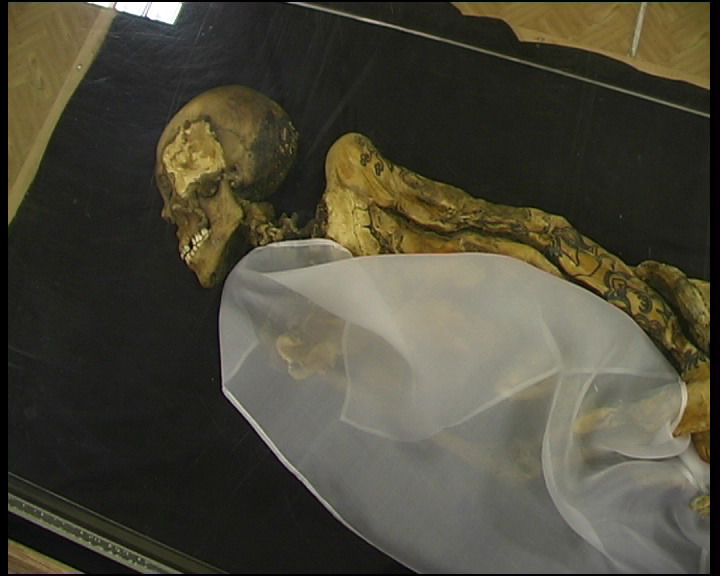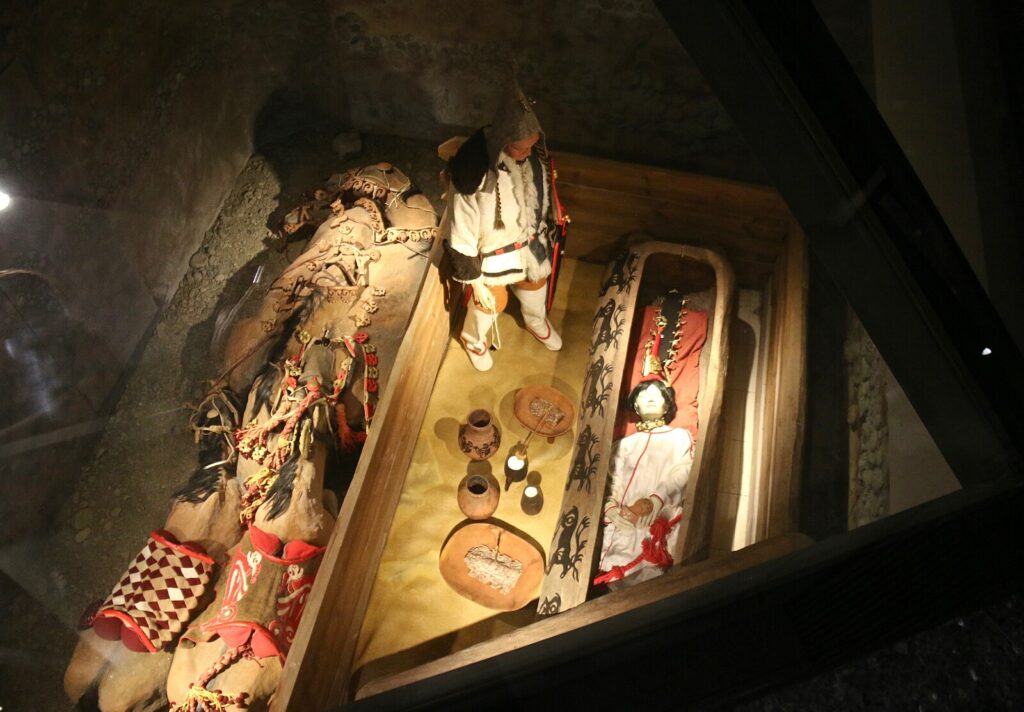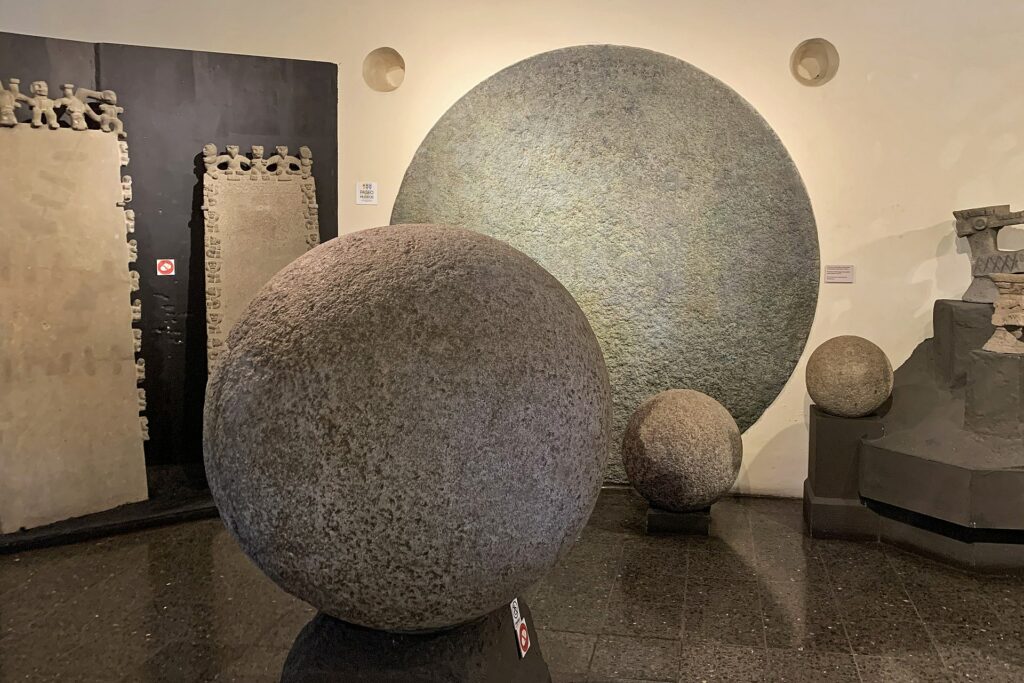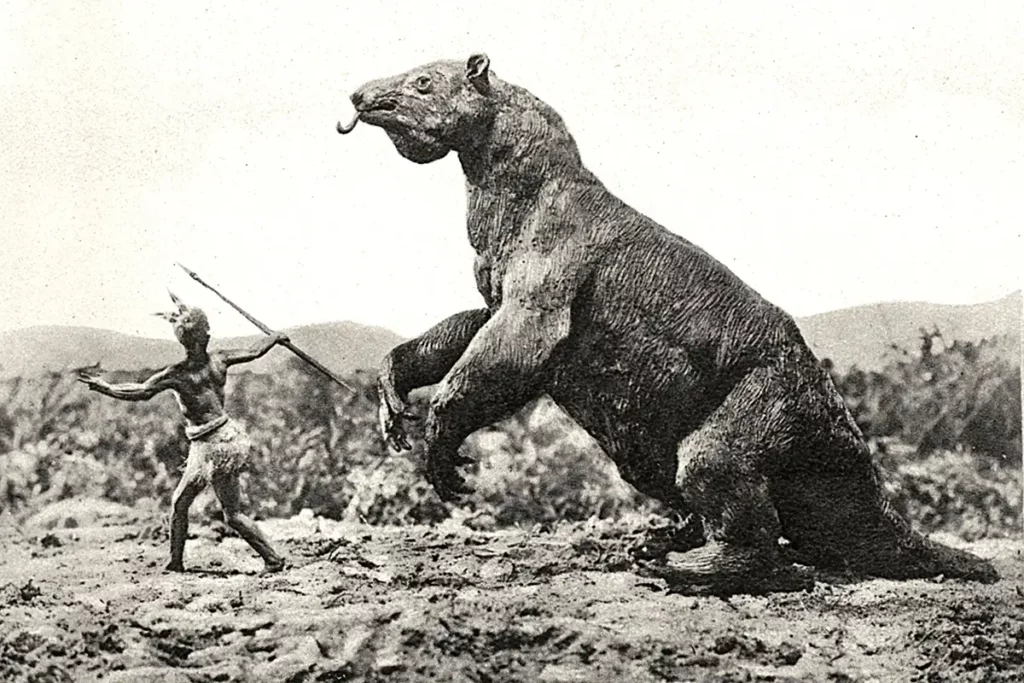One of the greatest archeological discoveries of the twentieth century came only seven years before the new millennium.
In 1993, Dr. Natalya Polosmak of Novosibirsk’s Institute of Archeology and Ethnography led a team of archeologists into the Eurasian steppe because of rumors of a grave robbery. The team began digging at a site on the Ukok Plateau in the Altai mountains, near the borders of Russia, China, and Kazakhstan, in what is now the Altai Republic.
What they found would soon grant scientists insight into a nomadic society from 2500 years ago.

Excavating the Tomb
As the team dug into the site, they discovered a large ice block under the dirt. Within the mountain range, burial sites would commonly flood and then freeze with the changing of the seasons, preserving the bodies within.
Using buckets of hot water, the team began to melt the block and uncover the mystery of the tomb. In the center, they found a young woman’s preserved body covered in tattoos, including one shaped like a griffin on her shoulder.
Surrounding her body were six horses. Each had been ritualistically killed with a pickaxe through the skull. There was also a feast of mutton, clear signs that the woman buried here had a high social status.
But without a clear sign of her identity, scientists can only speculate what her life was like. The team removed the body from the site and took it back to Novosibirsk. She would remain there for nearly the next two decades as scientists tried to draw every detail they could from her frozen and nearly perfectly preserved remains.
Uncovering Her Life Story
Further investigations into the body granted more insight into the woman’s life and her role in Pazryrk society. The woman had been embalmed and had all of her organs removed, including her brain. This made determining a cause of death difficult.
However, scientists have conducted extensive research on the corpse, including multiple MRIs. They found that the woman suffered from chronic illness and suffered an injury late in life from falling off a horse.
They theorized based on breast tissue, that the woman suffered from and may have died of breast cancer. Although cancer has been recorded in human records for thousands of years, this was the first time scientists could identify proof of cancer in mummified remains using modern technology.
Further analysis showed that the woman may have smoked marijuana, likely to cope with the pain of the tumor growing in her chest and her chronic pain. Research also showed that she regularly inhaled fumes of copper and mercury. This could imply that she commonly partook in rituals or ceremonies that required incense.
Princess or Shaman?
After investigating the rest of the tomb and contextualizing the burial site with other knowledge of the region, scientists identified the woman as a member of the Pazyryk culture. This was a group of nomadic people who lived in the Altai mountains from the 6th to 3rd century BCE.
It is believed that the tribes spent most of their lives on horseback, rotating through the region with the seasons. Other burial grounds excavated support this theory, although many other uncovered tombs are more extravagant in nature than the Ice Maiden’s.
The tomb instead indicated that she was somewhere in the middle class of Pazyryk society. Archeological evidence points to the fact that her body may have been preserved for up to six months and transported with the tribe as they migrated.
When considering this alongside the woman’s marijuana and ceremonial incense inhalation, scientists theorize that she may have been a shaman, not a princess as originally posited. She was important enough to receive an extensive burial ceremony, but not to have an extravagant tomb.

Local Backlash
The excavation of the tomb, while revolutionary for archaeology and ethnography, caused tension and anger within the local Altai Republic community. The woman had been part of local folklore for centuries and was an important connection to the community’s nomadic ancestors.
When the archaeologists excavated the site, the hot water they used to melt the ice damaged some of the relics and parts of the mummified remains. The body was then removed from the site and studied in Novosibirsk for nearly two decades. The body was also displayed around the world to showcase the woman’s tattoos.
In 2012, after much protest from the Altai people, Russia returned the body to a special mausoleum in the Altai capital of Gorno-Altaysk. While this appeased some, many Altai people are still calling for more.
They want the body reinterred on the plateau. Some see this as a dedication to respecting Pazyryk culture, while others believe removing the body had negative supernatural effects. By returning it, they can rectify a string of earthquakes and floods that have plagued the region.
The young shaman may have suffered in life, but in death, she has granted scientists a glimpse into the murky past of nomadic tribes in Russia. Her unique burial conditions and well-preserved remains have given scientists previously unknown details about the social hierarchy of the Pazyryk people.
Her body has also offered a glimpse into the realities of chronic pain and cancer in ancient societies, and the intricacies of early Siberian tattoos.
After 20 years of investigations and research, the body has finally been returned to its local community. Hopefully, the Russian scientists and Altai people can come to an agreement that allows for further investigations while also honoring the culture of Altai.
References
Dasgupta, Prateek. “The Story Behind the Siberian Ice Maiden and Her Tattoos.” Medium, June 2, 2021. https://medium.com/teatime-history/the-story-behind-the-siberian-ice-maiden-and-her-tattoos-acfcacf70dc4.
Liesowska, Anna. “Iconic 2,500 year old Siberian princess ‘died from breast cancer’, reveals MRI scan.” The Siberian Times, October 14, 2014. https://siberiantimes.com/science/casestudy/features/iconic-2500-year-old-siberian-princess-died-from-breast-cancer-reveals-unique-mri-scan/.
“Meet The 2500 Year Old Siberian Ice Maiden And Her Tattoos.” The Archaeologist, October 3, 2022. https://www.thearchaeologist.org/blog/meet-the-2500-year-old-siberian-ice-maiden-and-her-tattoos.
Readman, Kurt. “The Ice Maiden: Who was the Frozen “Princess” of Ukok?” Historic Mysteries, November 24, 2021. https://www.historicmysteries.com/princess-of-ukok/.

